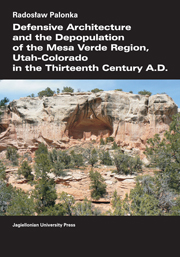Book contents
- Frontmatter
- Dedication
- Contents
- List of Figures
- Acknowledgments
- CHAPTER I Introduction
- CHAPTER II Mesa Verde region – definition, natural environment, history and methodology of research
- CHAPTER III Defining and interpreting defensive architecture
- CHAPTER IV Ethnography, ethnohistory, and Native American oral traditions concerning defensive architecture and conflicts in the Southwest
- CHAPTER V Analysis of the central Mesa Verde region architecture in the thirteenth century A.D.
- CHAPTER VI Summary and conclusions
- REFERENCES
- PHOTOGRAPHS
CHAPTER VI - Summary and conclusions
Published online by Cambridge University Press: 05 September 2014
- Frontmatter
- Dedication
- Contents
- List of Figures
- Acknowledgments
- CHAPTER I Introduction
- CHAPTER II Mesa Verde region – definition, natural environment, history and methodology of research
- CHAPTER III Defining and interpreting defensive architecture
- CHAPTER IV Ethnography, ethnohistory, and Native American oral traditions concerning defensive architecture and conflicts in the Southwest
- CHAPTER V Analysis of the central Mesa Verde region architecture in the thirteenth century A.D.
- CHAPTER VI Summary and conclusions
- REFERENCES
- PHOTOGRAPHS
Summary
On the basis of the analytic data contained in Chapter V, as well as comparison with other areas and cultures presented elsewhere in this book, I conclude that in the thirteenth century A.D. in the central Mesa Verde region, population aggregation, specific architectural characteristics, and choice of site location were determined to a great extent by a need for defense and protection for both the residents of the area and their food supplies. Archaeological data – primarily excavation and survey reports and my own observations in the central Mesa Verde region, particularly in the lower portion of the Sand Canyon locality – are supported by other sources of information that include ethnographic and ethnohistoric records and Native American oral traditions. I also use ethnographic analogy with indigenous cultures in other parts of the Southwest and North America as well as other areas of the world, mostly prehistoric non-state societies in central-eastern and southern Europe.
My conclusions consist of several aspects of site configuration and architecture at large sites, mostly community centers, across the central Mesa Verde region as well as at small sites in the Castle Rock community. The associated data are presented in Chapter V and include site location, layout, access, availability of water, and presence of defensive structures and features such as towers, protecting walls, loopholes, and tunnels.
- Type
- Chapter
- Information
- Defensive Architecture and the Depopulation of the Mesa Verde Region, Utah-Colorado in the Thirteenth Century AD , pp. 163 - 184Publisher: Jagiellonian University PressPrint publication year: 2011



